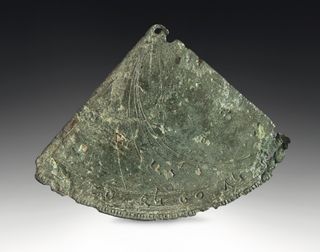Apple-1 Computer & Rare Enigma Machine Up for Auction

Forget scanning electron microscopes, high-speed centrifuges and computer-controlled telescopes — some of the coolest science tools ever made are totally analog, incredibly old and available for purchase as part of a new online auction.
Hosted by Christie's auction house in London, the Seven Centuries of Science sale features some of the coolest scientific instruments from the 14th century onward. The online-only auction opened for bidding yesterday (Oct. 15) and lasts until Oct. 29.
The oldest artifact to hit the auction block is a horary quadrant — an instrument used to measure the time of day by calculating the altitude of the sun. It's expected to sell for at least $77,000, according to Christie's. [See photos of the historic science instruments up for auction]
Another old-school astronomical instrument up for sale is an astrolabe rete that may have been made by Georg Hartmann, one of the most prolific 16th-century manufacturers of these devices. The spindly, circular instrument was made circa 1530, and it rotates to simulate the movement of stars in the sky. The astrolabe could sell for more than $23,000, auction house officials said.
But for those who prefer cold hard cash to astronomical observations, there's the McFarlane calculating cylinder, a rotating tube used to calculate monetary interest. The device was used before the advent of computing to perform routine (but difficult) calculations involving multiplication, division and square roots.
An instrument that functions similar to the McFarlane cylinder, but with a much different look, is also for sale. Fuller's computing telegraph dates back to 1852. The circular cardboard instrument has discs that spin around a metal pin. The discs serve different purposes, with one that can be used to determine the number of days or weeks between two dates, and another "logarithmic" disc that comes in handy when figuring out areas, distances, weights and volumes.
Other mathematical devices up for auction are a bit more mechanical than the Fuller and McFarlane instruments. For example, the first-ever commercially successful calculator, the Thomas de Colmar arithmometer, looks like a bunch of little knobs and gears tucked inside a quaint wooden box. The clunky machine may not seem as high-tech as modern calculators, but it was revolutionary when it first became commercially available in the mid-19th century. One contemporary review of the device raved that it could calculate the multiplication of eight-figure sums by eight-figure sums in less than 18 seconds.
Sign up for the Live Science daily newsletter now
Get the world’s most fascinating discoveries delivered straight to your inbox.
Only 60 or so Thomas de Colmar arithmometers are known to still exist, and this one is expected to sell for at least $7,700, according to Christie's. But that sum pales in comparison to the $93,000 minimum bid that could be thrown down for a rare Enigma machine, which is also up for auction. Forces in Nazi Germany once used the machine to send and decode clandestine messages. A similar Enigma machine recently sold at auction for about $233,000.
However, if you really have money burning a hole in your pocket, then you may be interested in owning a bit of computing history. Christie's is auctioning off an Apple-1 personal computer. Developed in 1976 by computing prodigy Steve Wozniak and marketing genius Steve Jobs, the super-retro computer is literally the mother of all Macs. Only 50 or so of these computers are known to still exist. The minimum bid for this bit of tech memorabilia is just under $400,000, but it could sell for closer to $800,000, according to Christie's.
The Seven Centuries of Science sale will continue online until Oct. 29.
Follow Elizabeth Palermo @techEpalermo. Follow Live Science @livescience, Facebook & Google+. Original article on Live Science.

Elizabeth is a former Live Science associate editor and current director of audience development at the Chamber of Commerce. She graduated with a bachelor of arts degree from George Washington University. Elizabeth has traveled throughout the Americas, studying political systems and indigenous cultures and teaching English to students of all ages.
Most Popular

